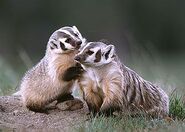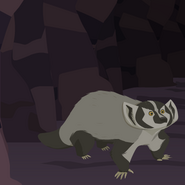
The American badger (Taxidea taxus) is a North American badger, somewhat similar in appearance to the European Badger. It is found in the western and central United States, northern Mexico, and south-central Canada to certain areas of southwestern British Columbia. American badger habitat is typefied by open grasslands with available prey (such as mice, squirrels, and groundhogs). The species prefers areas such as prairie regions with sandy loam soils where it can dig more easily for its prey.
Taxonomy[]
The American badger is a member of the Mustelidae, a diverse family of carnivorous mammals that also includes the weasel, otter, ferret, and wolverine. The American badger belongs to the Taxidiinae, one of three subfamilies of badgers - the other two being the Melinae (9 species, including the Eurasian badger) and the Mellivorinae (honey badger). The American badger's closest relative is the prehistoric Chamitataxus. Recognized subspecies include: the nominate subspecies T. t. taxus, found in central Canada and central US; T. t. jacksoni, found in the southern Great Lakes region including southern Ontario; T. t. jeffersoni, in British Columbia and the western US; and T. t. berlandieri, in the southwestern US and northern Mexico. Ranges of subspecies overlap considerably, with intermediate forms occurring in the areas of overlap. In Mexico, this animal is sometimes called tlalcoyote. The Spanish word for badger is tejón, but in Mexico this word is also used to describe the coati. This can lead to confusion, as both coatis and badgers are found in Mexico.
Description[]
The American badger has most of the general characteristics common to badgers; with stocky and low-slung bodies with short, powerful legs, they are identifiable by their huge foreclaws (measuring up to 5 cm in length) and distinctive head markings. Measuring generally between 60 and 75 cm (23.6 to 29.5 inches) in length, males of the species are slightly larger than females (with an average weight of roughly 7 kg (15.5 pounds) for females and up to almost 9 kg (19.8 pounds) for males). Northern subspecies such as T. t. jeffersonii are heavier than the southern subspecies. In the fall, when food is plentiful, adult male badgers can exceed 11.5 kg (25.3 pounds). The American badger has most of the general characteristics common to badgers; with stocky and low-slung bodies with short, powerful legs, they are identifiable by their huge foreclaws (measuring up to 5 cm in length) and distinctive head markings. Measuring generally between 60 and 75 cm (23.6 to 29.5 inches) in length, males of the species are slightly larger than females (with an average weight of roughly 7 kg (15.5 pounds) for females and up to almost 9 kg (19.8 pounds) for males). Northern subspecies such as T. t. jeffersonii are heavier than the southern subspecies. In the fall, when food is plentiful, adult male badgers can exceed 11.5 kg (25.3 pounds).
Diet[]
The American badger is a fossorial carnivore. It preys predominantly on pocket gophers (Geomyidae), Ground Squirrels (Spermophilus), moles (Talpidae), marmots (Marmota), prairie dogs (Cynomys), pika (Ochotona), woodrats (Neotoma), kangaroo rats (Dipodomys), deer mice (Peromyscus), and voles(Microtus), often digging to pursue prey into their dens, and sometimes plugging tunnel entrances with objects. The American badger is a significant predator of snakes including rattlesnakes, and are considered the most important predator of rattlesnakes in South Dakota. They also prey on ground-nesting birds, such as the sand martin (Riparia riparia) and burrowing owl (Athene cunicularia), and lizards, amphibians, carrion, fish, skunks (Mephitis and Spilogale), insects, including bees and honeycomb, and some plant foods such as corn (Zea mais), peas, green beans, mushrooms and other fungi, and sunflower seeds (Helianthus).
Behavior[]
American badgers are generally nocturnal; however, in remote areas with no human encroachment they are routinely observed foraging during the day. Seasonally, a badger observed during daylight hours in the Spring months of late March to early May often represents a female foraging during daylight and spending nights with her young. Badgers do not hibernate, but may become less active in winter. A badger may spend much of the winter in cycles of torporthat last around 29 hours. They do emerge from their burrows when the temperature is above freezing.
An abandoned badger burrow may be occupied by mammals of similar size, such as foxes and skunks, as well as animals as diverse as the burrowing owl, California Tiger Salamander and California Red-Legged Frog. A widely held misconception is that badgers and coyotes hunt together. Badgers are solitary foragers; coyotes will observe badgers in the process of foraging and position themselves in proximity in order to attempt to capture any prey seeking to escape. Thus the human projection that badgers and coyotes form a mutually beneficial relationship in hunting and foraging is in error: the benefit favors the coyote, which are not as effective in digging prey out of burrows as badgers and act opportunistically in seizing prey the badger flushes or loses grasp of.
Life Cycle[]
Badgers are normally solitary animals, but are thought to expand their territories in the breeding season to seek out mates. Mating occurs in late summer and early fall, with some males breeding with more than one female. American badgers experience delayed implantation, with pregnancies suspended until December or as late as February. Young are born from late March to early April in litters ranging from one to five young, averaging about three. Badgers are born blind, furred, and helpless. Eyes open at four to six weeks. The female feeds her young solid foods prior to complete weaning, and for a few weeks thereafter. Young American badgers first emerge from the den on their own at five to six weeks old. Families usually break up and juveniles disperse from the end of June to August; young American badgers leave their mothers as early as late May or June. Juvenile dispersal movements are erratic.
Habitat[]
American badgers prefer grasslands and open areas with grasslands, which can include parklands, farms, and treeless areas with friable soil and a supply of rodent prey. They may also be found in forest glades and meadows, marshes, brushy areas, hot deserts, and mountain meadows. They are sometimes found at elevations up to 12,000 feet (3,600 m) but are usually found in the Sonoran and Transition life zones (which are at elevations lower and warmer than those characterized by coniferous forests). In Arizona, they occur in desert scrub and semidesert grasslands. In California, American badgers are primarily able to survive through a combination of open grasslands of agricultural lands, protected land trust and open space lands, and even regional and state and national park lands with grassland habitat. The Sonoma County badger population includes some protected and private lands near the Sonoma Coast, as well as one in South Sonoma County fragilely surviving in spite of abundant prey due to fragmentation. Badgers are occasionally found in open chaparral (with less than 50% plant cover) and riparian zones. They are not usually found in mature chaparral. In Manitoba aspen parklands, American badger abundance was positively associated with the abundance of Richardson's ground squirrels (Spermophilus richardsonii). In Ontario it primarily resides on the extreme southwestern portion of the province, restricted to the north shore of Lake Erie in open areas generally associated with agriculture and along woodland edges. There have been a few reports from the Bruce-Grey region.
American badger use of home range varies with season and sex. Different areas of the home range are used more frequently at different seasons and usually are related to prey availability. Males generally have larger home ranges than females. In a study almost 40 years ago, radiotransmitter-tagged American badgers had an average annual home range of 2,100 acres (850 ha). The home range of one female was 1,790 acres (725 ha) in summer, 131 acres (53 ha) in fall, and 5 acres (2 ha) in winter. Lindzey reported average home ranges of 667 to 1,550 acres (270–627 ha). Estimated density of American badgers in Utah scrub-steppe was one per square mile (2.6 km2), with 10 dens in active or recent use. In 2014, overdevelopment of American Badger habitat has resulted in reduced range, decreased prey, and forced badgers into contact with man foraging between fragments. Direct observations in Sonoma County, documenting habitat and badger sightings and foraging, reflect various ranges within the fragmented habitat areas from less than 1/2 mile to approximately 4 miles. Within these areas, the availability of prey and a fresh water source are key factors for the preferred habitat areas and ability to survive. Identifying and conserving habitat areas where there is year-round activity, along with identified burrowing patterns and observations of female badger territory for birthing and raising young have become critical factors in survival of the species.
Predation[]
While the American badger is an aggressive animal with few natural enemies it is still vulnerable to other species in its habitat. Predation on smaller individuals by golden eagles (Aquila chrysaetos), coyotes, cougars (Puma concolor), and bobcats (Lynx rufus) have been reported. Bears (Ursus spp.) and gray wolves (Canis lupus) occasionally kill American badgers. American badgers are trapped by humans for their pelts. Their fur is used for shaving and painting brushes.




